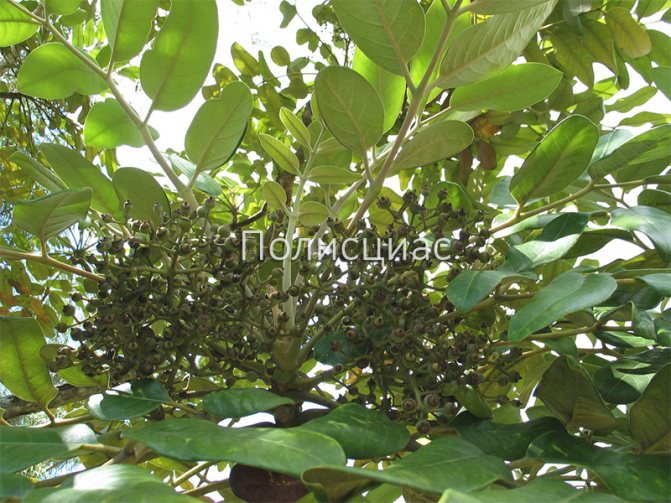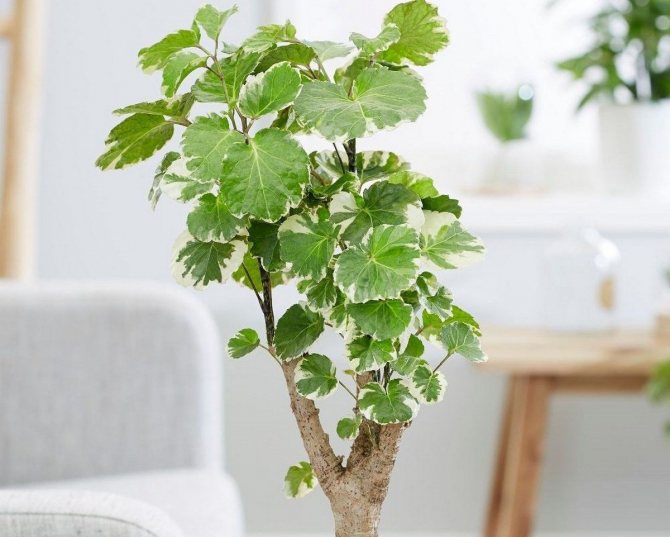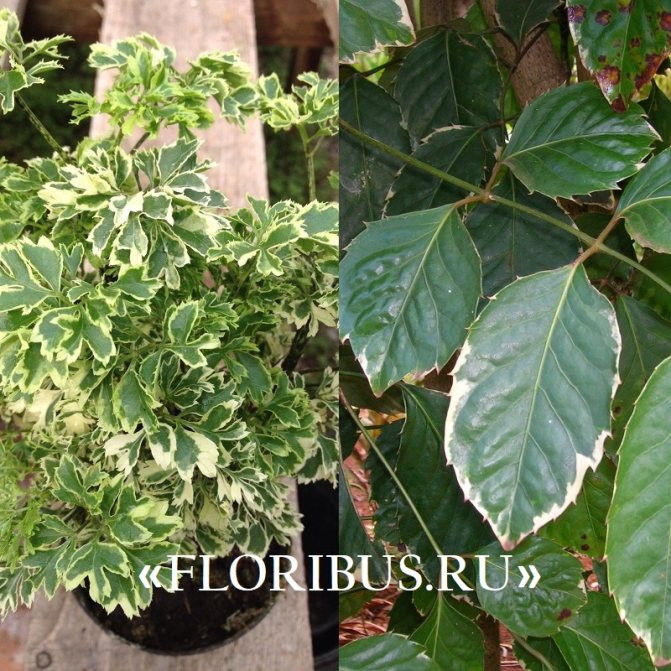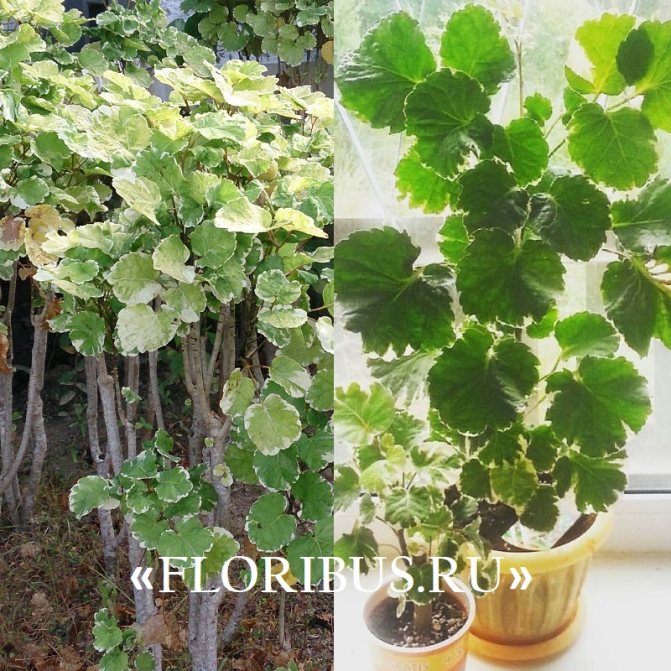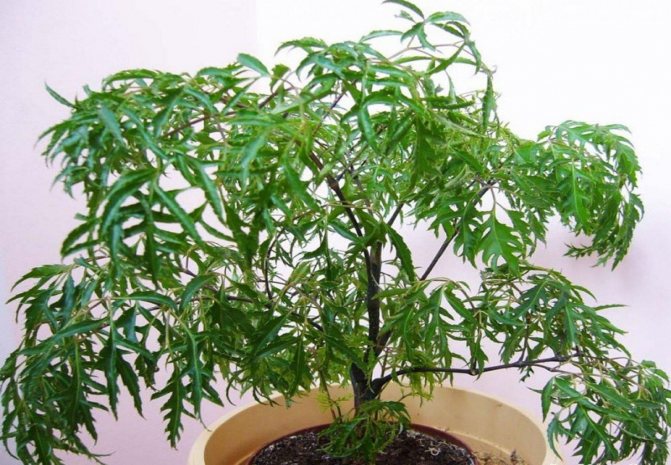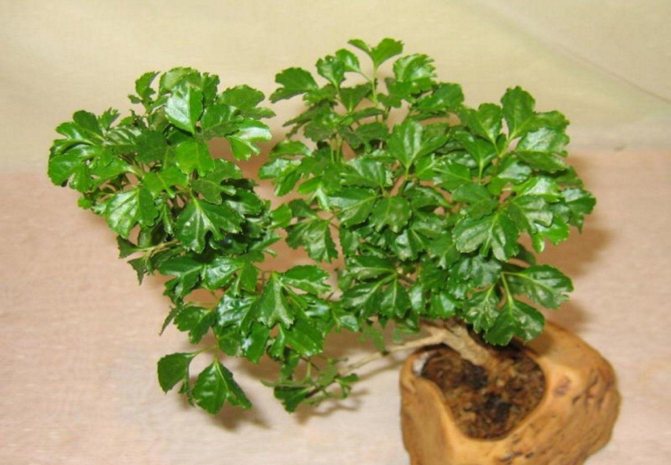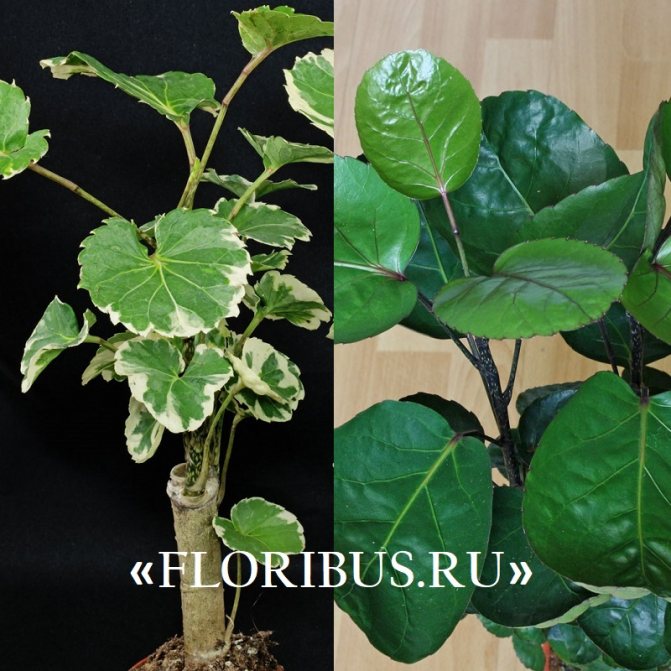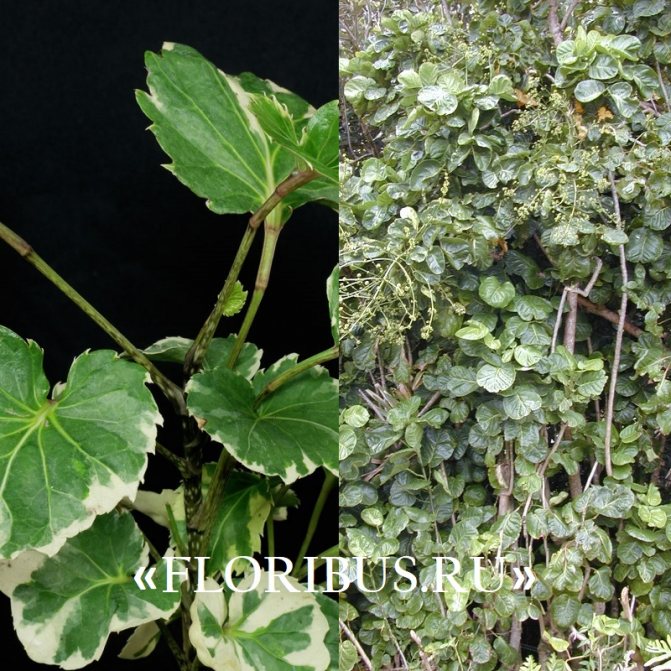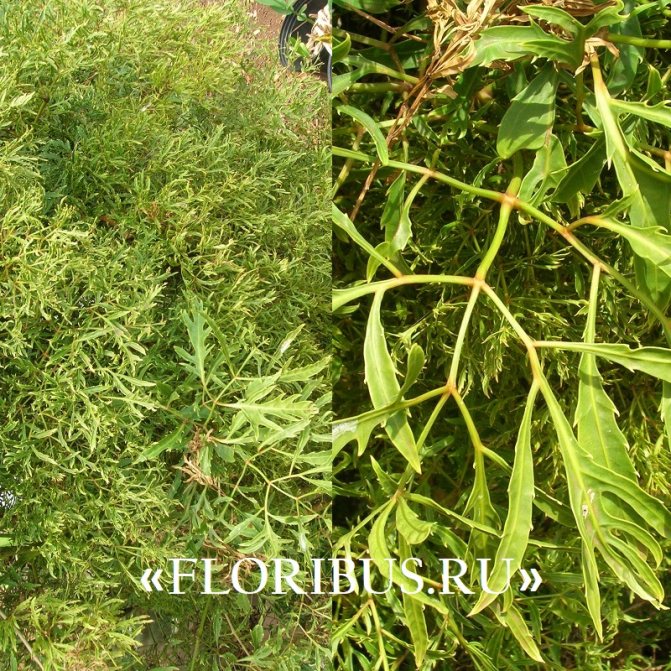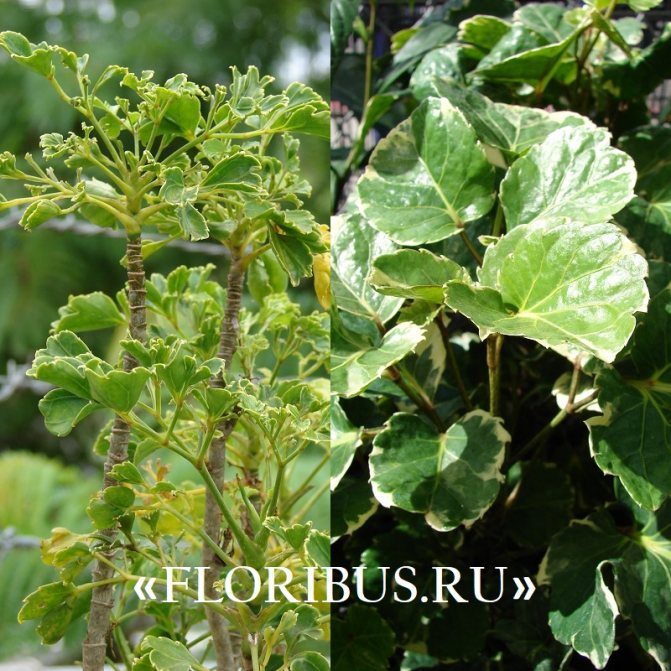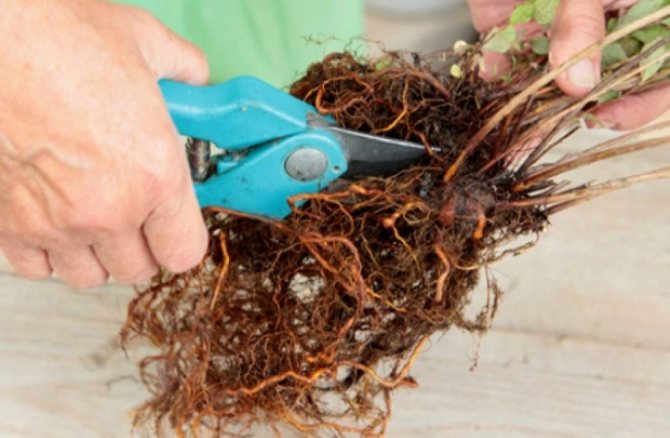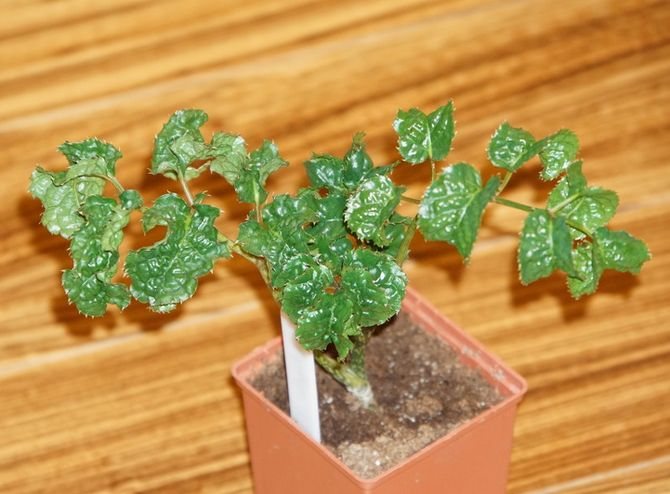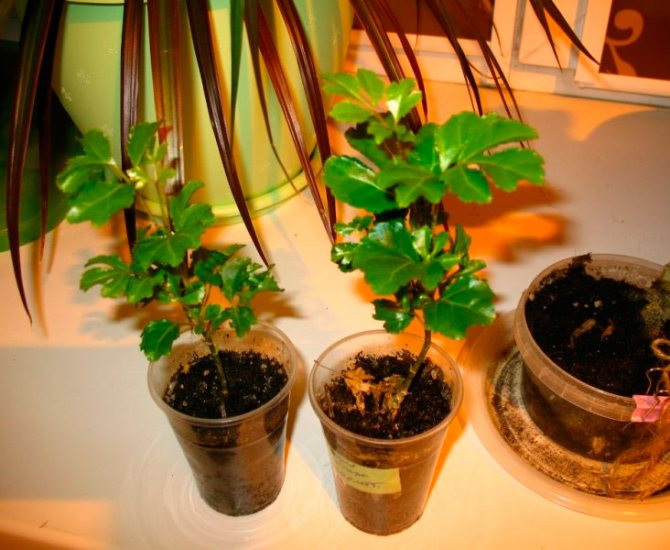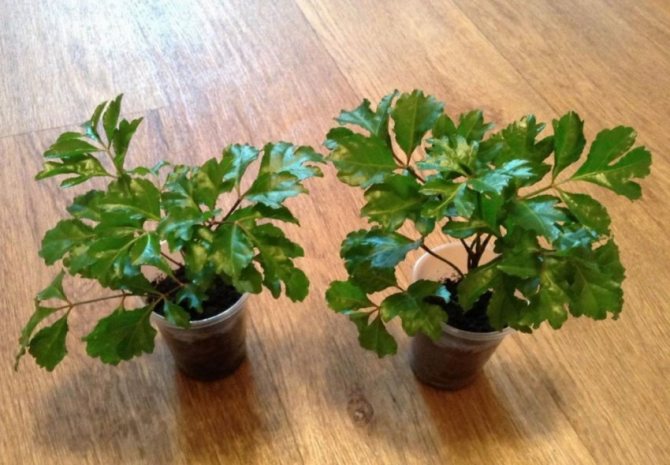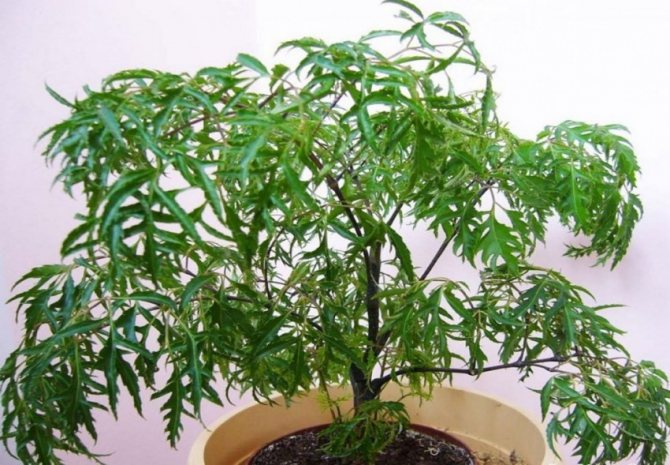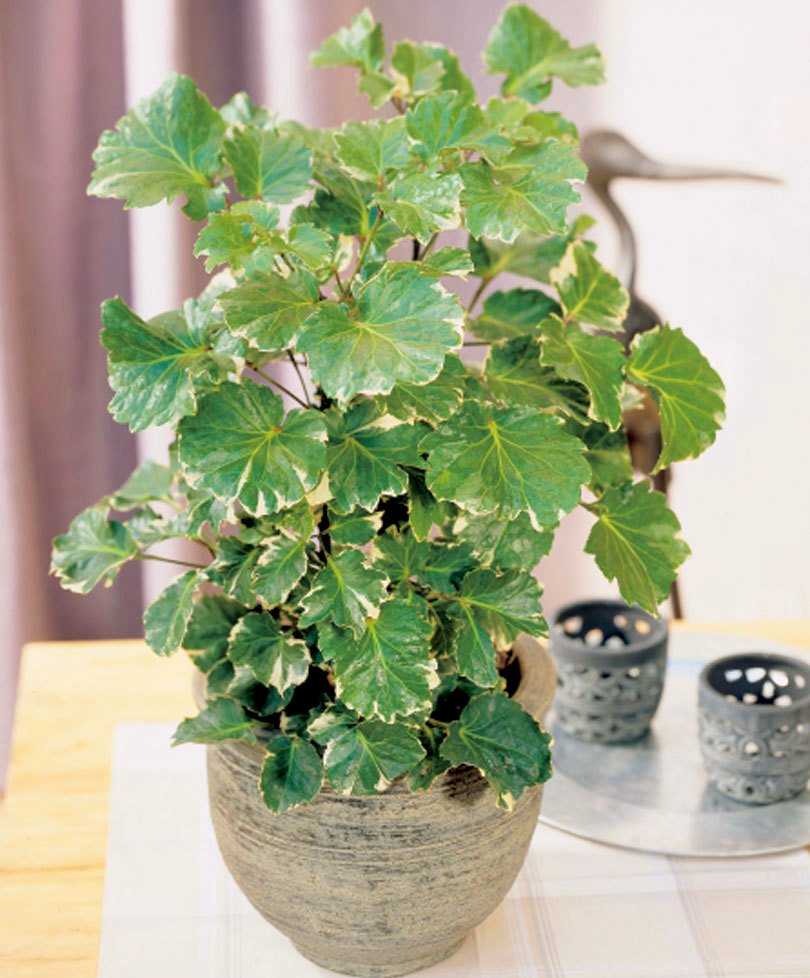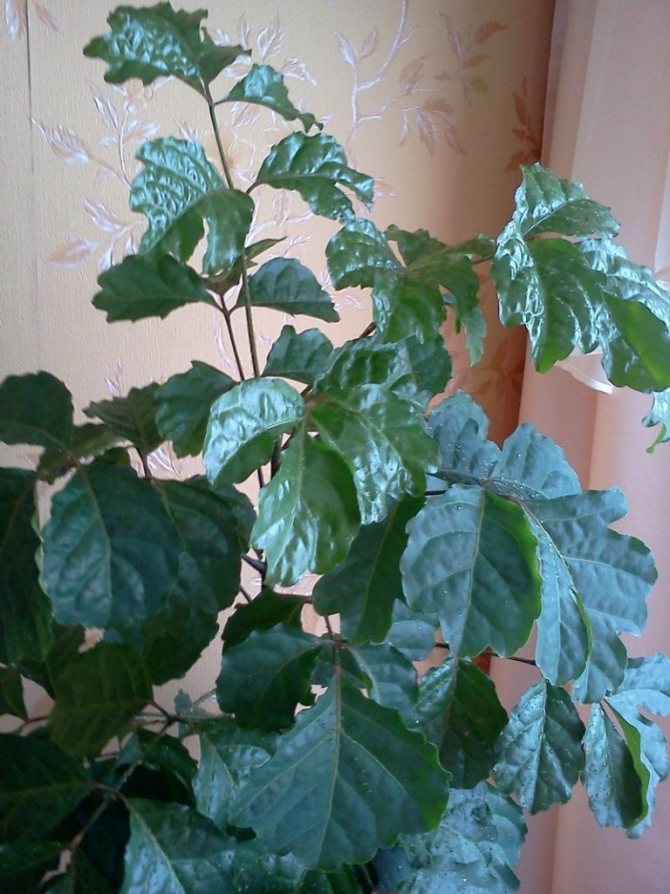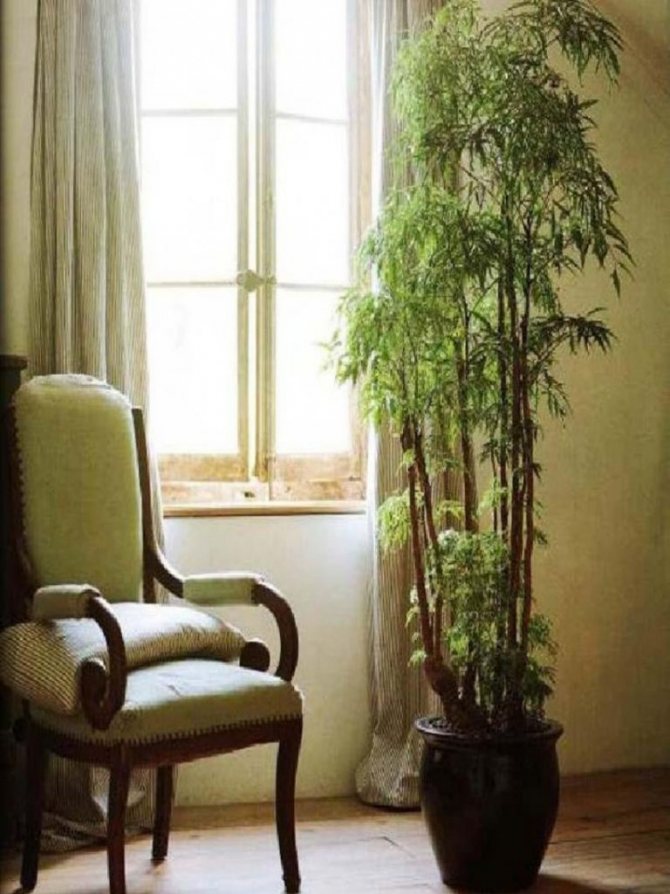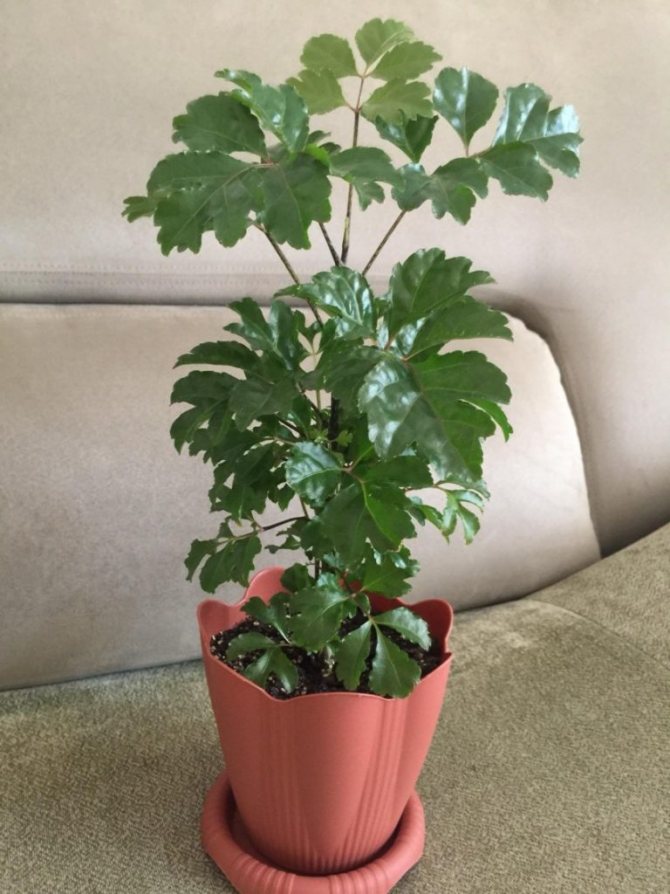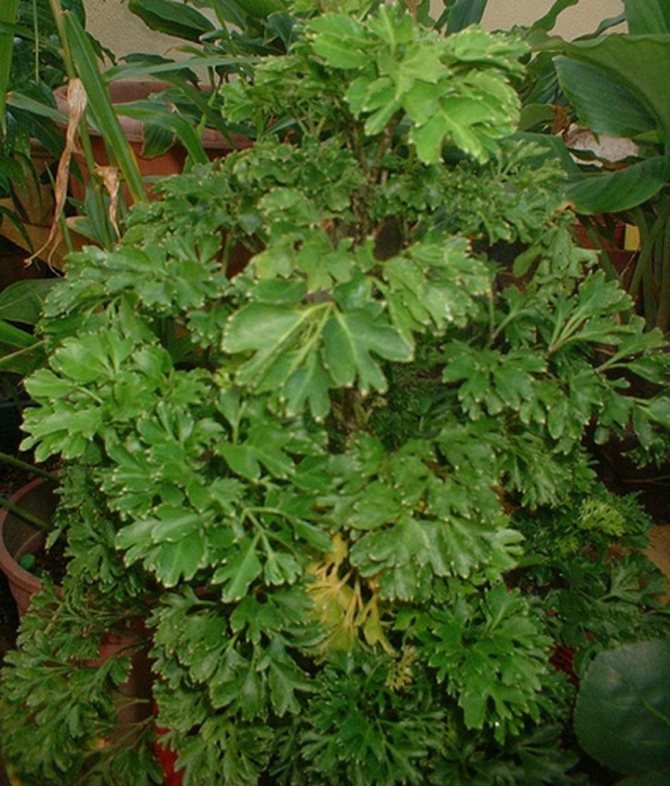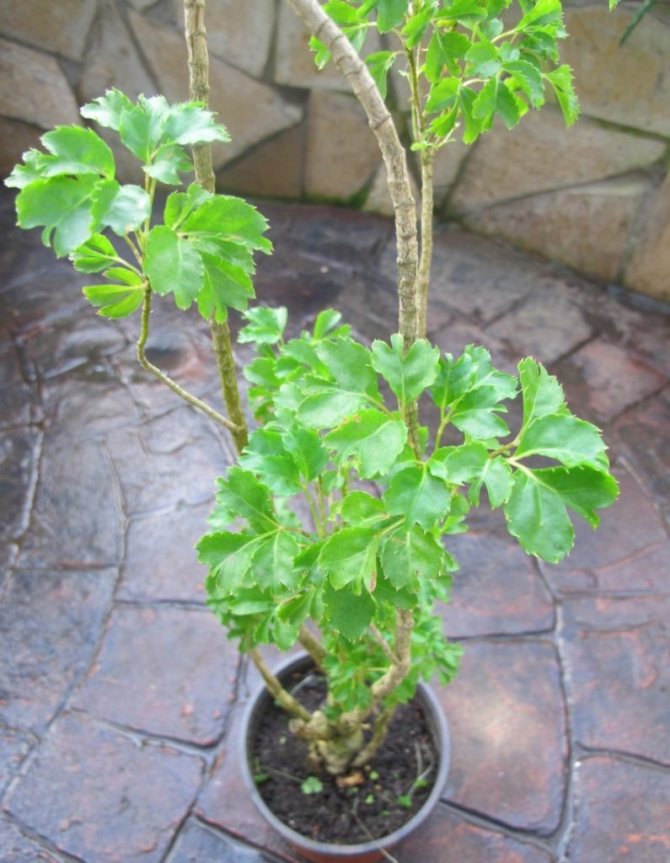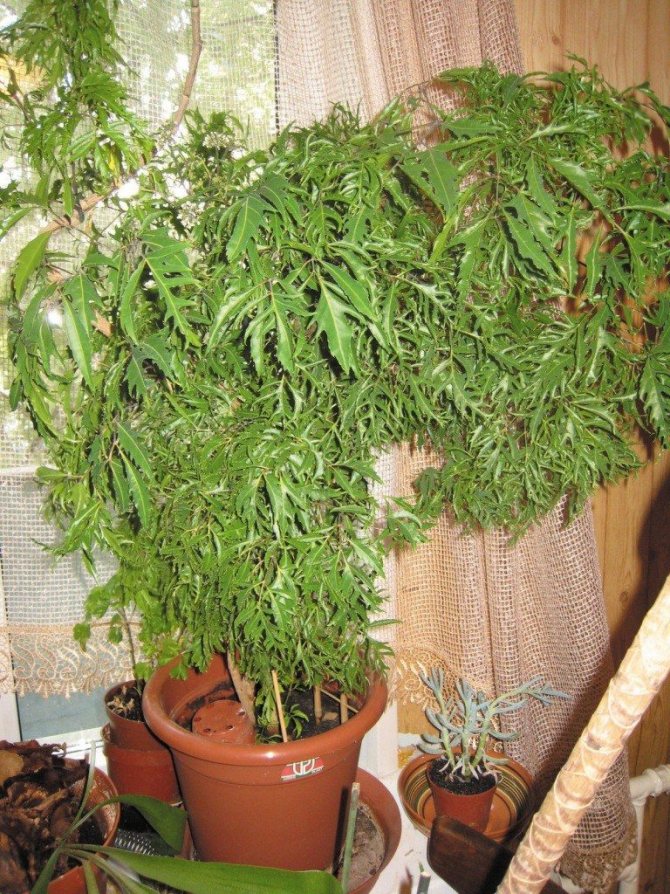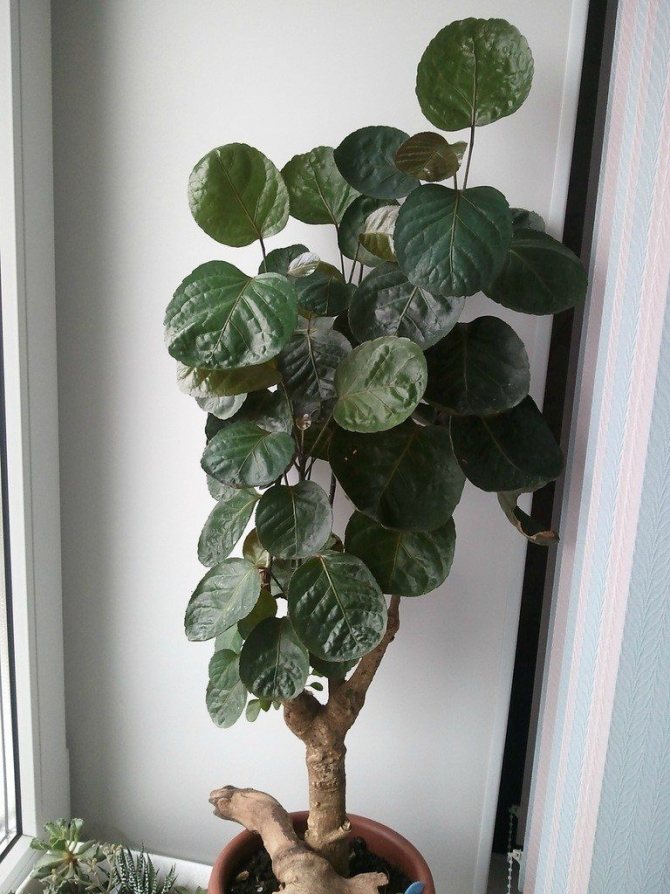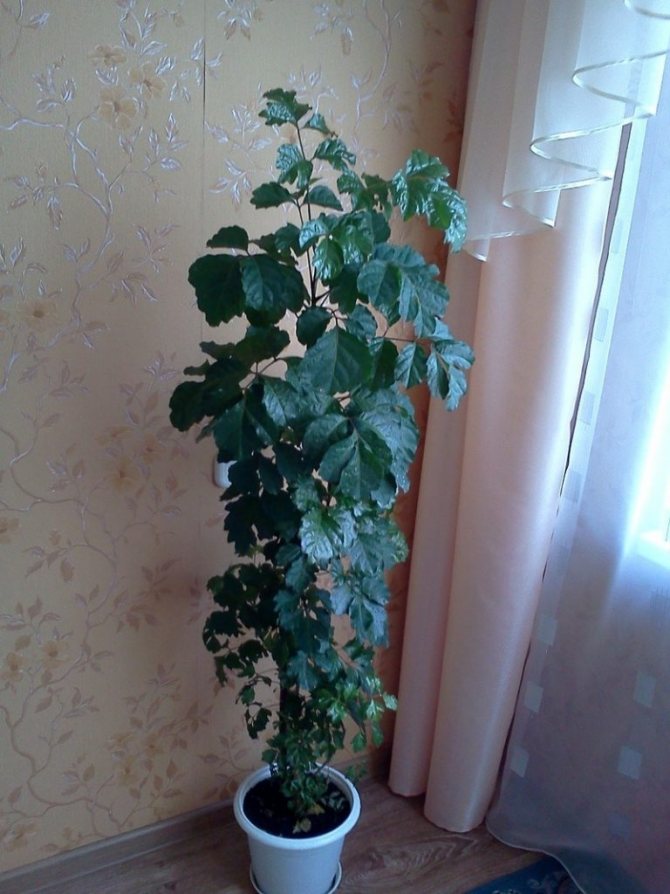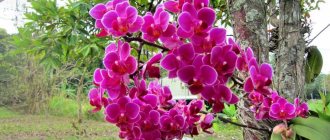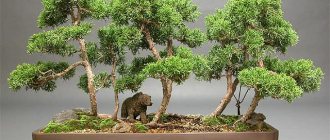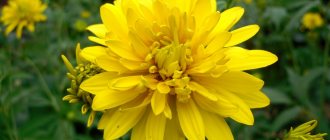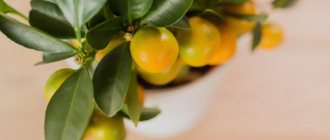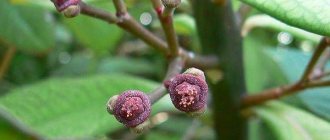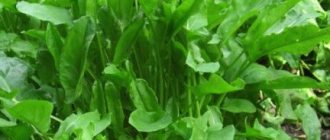A beautiful, unobtrusive plant is capable of single-handedly transforming a particular room, be it an office or an apartment. Today we will tell you about the wonderful culture that is cultivated by modern breeders for home keeping. Next, we will talk about the polisias plant. We will touch upon not only information about the plant, but also give practical recommendations for the maintenance and care of the police.
The most popular types of polisias that are grown at home and their photographs
Of the whole variety of polisias in indoor floriculture, several species are represented. Ornamental deciduous shrubs and trees have become a real decoration and many amateur flower growers would like to purchase a plant for themselves.
- Poliscias dull-leaved one of the types recommended for indoor floriculture. It adapts well to home conditions. It grows best on east and west windows, where the sun is not very bright and scorching. At the beginning, the seedling grows as a single plant, over time, additional shoots grow from the root and a bush is formed. The leaf plate is bright, deep green, rounded three-lobed. Outwardly, it resembles an oak leaf. Grows up to 1-1.5 meters.
- Helmet Polisias attracts flower growers with its unusual trunk. Thick, bizarrely curved. Growing up to two-thirds of its size, it rushes upward with straight, almost non-branching thin shoots with almost round dark green leaves. Some varieties of this species have a more dissected leaf and a white canvas. The plant is not spreading, several shoots grow up from the root. Pruning can hold back growth. In the wild, it grows more than two meters.
- Guilfoyle very tall appearance with feathery dissected leaves. Carved sheet, toothed. A yellow or white border adorns the edge beautifully. At home, it grows more than three meters in height. Most often grown in greenhouses or as a single large plant for organizations. Smaller varieties have been developed for indoor floriculture. One of them is "Victoria".
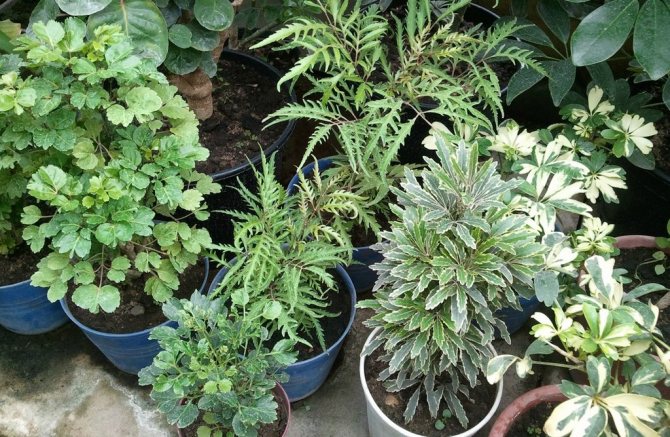
Photo. The most popular types of polisias
- Shrub species most often found in home floriculture. The plant is in the form of a bush, with numerous thin shoots. The twigs are decorated with dark green, shiny leaves. Different varieties of leaves have a different dissection. On the same plant, leaflets of different shapes are found. Of all the types of poliscias, the shrub is the most unpretentious. It can live in partial shade, easily tolerates a short-term decrease in humidity. At home, it grows into a huge openwork bush, up to 3.5 meters. It is used by the local population for the preparation of various recipes of traditional medicine and as a spice in cooking.
- Paniculate... Low-growing evergreen shrubs. The leaf is pinnate, dissected. The color of the leaves is varied. Some varieties with solid bright green leaves, others with large yellow spots all over the leaf plate, there are plants with small spots and stripes. In insufficient light, the sheet becomes monotonous; in direct sunlight, the pattern fades. Grows well in partial shade.
When does the polisias bloom?
To see how the polisias bloom indoors is incredible luck, since this happens even less often than in cacti.However, this process itself does not attract much attention - it is just that several umbrella or paniculate inflorescences with small greenish-whitish flowers appear among the branches, which turn into round small seeds after a few weeks. They smell like dried dill.
polistsias-02.jpg


polyscias_filicifolia_by_fo.jpg
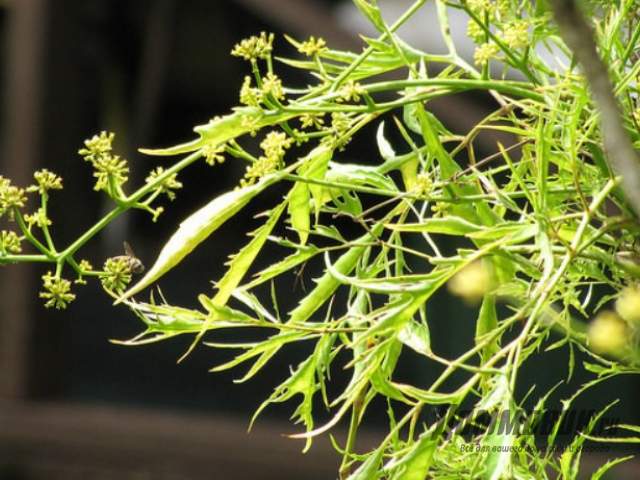

It is often possible to observe the flowering of the poliscias in greenhouses and conservatories, where the plant reaches its natural age and size. During this period, it practically does not differ from its closest relative, a deciduous tree growing on the street - the Manchurian aralia (pictured). According to experienced florists, the polisias blooms in April-May, the umbrellas open gradually, and this may last a little more than a month.
582113_d22d2467.jpg
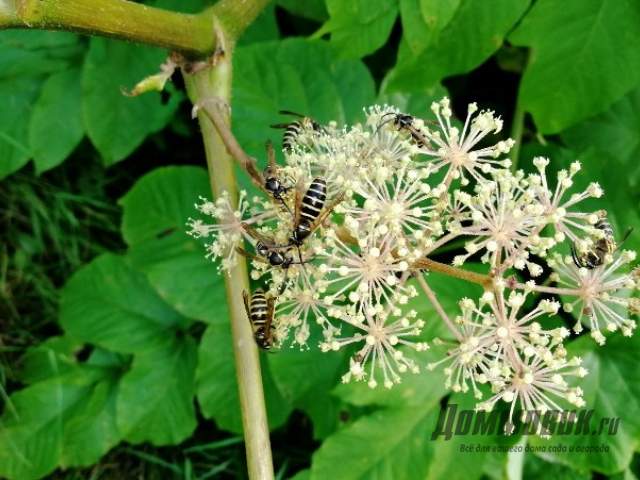

araliya_manchzhurskaya.jpg
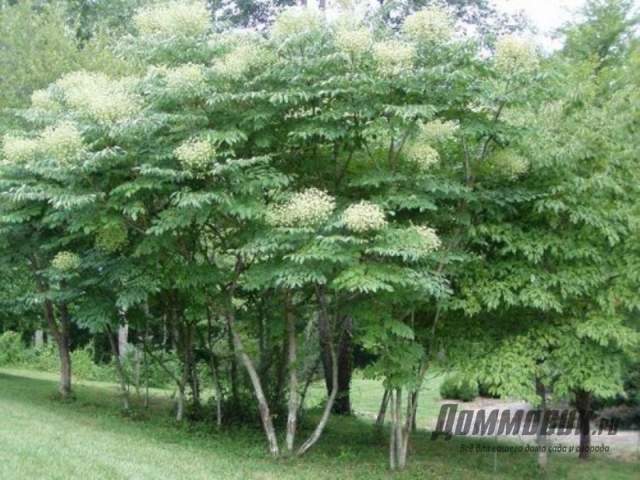

Caring for the police at home
In order for your policeman to grow well, you must follow certain rules for caring for him
Is it easy to take care of a police officer at home? Experienced flower growers will say that it is easy, but beginners will say that it is difficult. The Poliscias plant is not the easiest one. Even among its relatives, people from the tropics, it is considered capricious. But many growers managed to find an approach to it.
- Lighting. The plant is best kept near east, southeast and west windows. It is dangerous to put it on the windowsill, in winter the earthen lump will be hypothermic. Leaves touching the glass can freeze, and hot air from heating devices is detrimental to the plant. In summer, direct sunlight will burn the leaves .. But you should not place the plant far from the light source either. Poliscias grows well and develops in bright light. There are varieties that tolerate partial shade, but variegated specimens are very demanding on light. In case of insufficient lighting, in winter, it is necessary to organize artificial lighting. Otherwise, the plant will stretch out, the crown will become loose, not attractive.
- Temperature the room should be constant. 20 to 25 degrees. In winter, it can be several indicators less, but not lower than 18 degrees.
- Humidity one of the very important conditions for the successful development of a plant. The humidity should be high. This is especially true in winter, when central heating is connected. It is recommended to spray the plant several times a day (at least two), once every ten days to arrange a real warm shower. At the same time, the earthen ball must be protected from excess water. For this procedure, it is best to purchase a special attachment with very fine holes. Leave in the shower for 5-10 minutes. Many novice flower growers take out plants in the summer to fresh air and rain. For a policeman, this is disastrous. The only thing you can do is open the windows when it is raining.
- Watering. To understand how to properly water a plant, let's once again remember where its homeland is. Tropical showers are warm and plentiful, so we will water abundantly with well-settled water. We pour enough water so that it starts to come out through the drain hole. We leave it for 20 minutes. During this time, the earthen lump is saturated with water, we must remove excess moisture. In between waterings, we loosen the soil. The next time you need to water it after the top layer of the earth dries out by 2 cm. What is better to pour or underfill? Neither one nor the other. Poliscias reacts equally badly to a lack and an excess of water.
- Top dressing. Like all houseplants, the polisias needs regular feeding. From early spring to autumn, it is fed once every two weeks. It is best to use ready-made complex fertilizers for indoor plants. In the fall, the feeding is gradually reduced, brought up to once a month.During the dormant period, they do not feed.
Check out the most popular types and varieties of irises.
A detailed description and photos of Iberis can be found at the link
Reproduction and transplantation
Reproduction of the poliscias is carried out by rooting cuttings. This process is very painstaking. Young apical shoots or older, lignified branches can be rooted. The former have a more neat and decorative look, but the latter take root faster. In early spring, cuttings are cut with a length of 8-12 cm. Places of cuts must be sprinkled with crushed charcoal and dried for 3-4 hours. After that, the cuttings are slightly buried in a sand-peat mixture and watered. The pot must be covered with plastic or glass to create a greenhouse environment. The air temperature must be +25 ° C. Ventilate the greenhouse and spray the soil daily. Roots appear in 3-4 weeks.
Rooted cuttings and young plants are planted in small pots. The bottom of the container is lined with a layer of brick chips, clay shards or expanded clay. Land for planting should consist of:
- leafy soil;
- sod soil;
- humus;
- peat;
- river sand.


An adult indoor plant poliscias is transplanted less often (once every 2-3 years) by transshipment of an earthen coma.
Pruning a houseplant polisias
Pruning polisias, good for spring
Cropping is a fun and exciting process. Sometimes to the point where it hurts to look at a cut plant. But after a while new buds wake up, the crown becomes thicker, more attractive. If your plant is very elongated, the trunk is bare, it is better to prune it.
Polisias responds well to pruning. It is better to spend it in the spring, during the growing season. Use the trimmed parts of the plant for reproduction. If there is no special need for pruning, it is not necessary to do it. The plant itself develops in such a way that it looks very decorative.
Pros and cons of culture
The undoubted advantage of this culture is its attractive appearance and the ability to satisfy different tastes, since the genus Polyscias includes woody and shrub forms.
For an inexperienced gardener, caring for a policeman can present some difficulties - it is necessary to properly prepare the soil, place it in a comfortable place, monitor humidity and temperature.
The disadvantage is the poisonous sap of the plant, which, if it gets on the skin, can cause irritation. Therefore, when pruning and transplanting, you need to be careful and work with gloves, and then wash your hands.
Reproduction of the police at home
The polisias is propagated in two ways:
- Division of the bush. With this method, the bush is divided into two or more parts during transplanting in the spring. It is better to separate young shoots with a well-developed root system from an adult bush. Young seedlings are planted in separate small pots. Care for them as for adult plants.
- Cuttings. During pruning of an adult plant, cuttings with two or three internodes are prepared. The lower cut is made at an angle, the upper one is straight. Prepared cuttings are treated with growth stimulants (you can use "Kornevin") and planted one by one in prepared containers with peat and sand (1x1). It is advisable to arrange bottom heating. Cover the cuttings with a covering material or make a small greenhouse. After 30 days, root formation will begin. Shoots will appear on the cuttings. At this time, it is necessary to gradually accustom the seedlings, open the greenhouse for a short time, then remove it completely.
Benefit or harm?
One of the most unpleasant properties of the polisias is its toxicity. Its juice can cause chemical burns, getting it on the skin, mucous membranes, or in the eyes is unacceptable.Pruning and caring for the plant should be done with work gloves, after each procedure, wash your hands thoroughly with soap and water.
At the same time, the plant looks beautiful, unusual, and is able to decorate any home, and a few pieces turn the room into a kind of "corner of the tropics". This perennial shrub is a good candidate to form a bonsai, a dwarf tree that is a fun and exciting hobby to grow.
Planting, transplanting a flower at home
The police are transplanted every year
Young plants are transplanted annually in the spring. Adults as needed every three years. When transplanting becomes impossible due to the large size of the plant, the topsoil is replaced with a more fertile one instead. It is better to buy soil in a specialized store. If you cook yourself, take garden soil, add peat and river sand (2x1x1). Be sure to disinfect the mixture with a solution of potassium permanganate or steam it. Put expanded clay at the bottom of the pot. In order not to damage the roots, the polisias are not transplanted, but transferred without disturbing the earthen lump. Choose a pot 10 cm larger in diameter than the previous one. Roots rot in a large pot.
Description
The long, branching roots of the Poliscias are woven into a kind of netting, enveloping a lump of earth on all sides. Young shoots and stems have a greenish bark, later on it acquires a brownish tint. An interesting feature of the branches of this plant is their flexibility: the shoots of the poliscias can even be tied in a knot. The trunk of a young plant is densely covered with branches, but over time it becomes bare - the branches remain only at the top, forming a crown.
The length of the leaf petioles is small, the color is most often light green, but in some varieties of the polisias, the leaves are bordered by a strip, or painted with spots of white and beige colors. The shape of the leaves can be different: pinnate, oblong, round.
Poliscias flowers are small, white, collected in inflorescences, resembling an umbrella, and practically odorless. They can be seen only in the wild - in the conditions of an apartment, the policeman never blooms. The flowering period is replaced by a fruiting period, but these fruits are short-lived, and they are not used for artificial breeding.
Plant transplant after purchase
When choosing a plant in the store, pay attention to the ratio of the root to the crown. If the plant has a large, well-developed crown, and the root system is not very large, it is better not to buy such a plant. It is "fed" with growth stimulants and may die at home. It is better to buy a poliscias with a well-developed root system and a not very large trunk. To transplant the plants after purchase, decide for yourself. If the pot is sufficient in volume, the roots do not come out of the hole at the bottom of the pot, you can take your time and do the transplant later. If something does not suit you, it is better to transplant.
General information
Polisias belongs to the Araliev family. Ivy and fatsia are considered related species. His homeland is the Pacific Islands.
Other features:
- It looks like a low tree or small shrub with vertically directed branches.
- The stem is covered with brown bark as it grows, but retains its flexibility. The branches are almost impossible to break, but they are easy to bend and straighten again.
- Leaf plates are varied in shape and color. They are attached to the branches with short petioles. Species with variegated leaf color and carved edges are especially popular.
- Interestingly, young plants generally have a solid leaf blade. Over time, their edges separate and acquire bizarre outlines.
- Over the years, the lower third of the trunk loses its branches and leaves, the poliscias becomes like a bonsai.
- The root system is highly developed, growing both in depth and in width.Therefore, the pot will need a voluminous one.
Attention! Indoor flowering is rather an exception.
Pests, diseases and plant care during this period
Polisias is susceptible to pests such as: spider mites, scale insects and aphids
Pests. Aphids, scale insects, spider mites are the main pests. There are many different means to combat them. Before taking on chemicals, you can try folk remedies (decoctions of tobacco, infusion of onion peels). When there are many pests, insecticide treatment is necessary. If for some reason most of it is damaged by pests, it is better to prune it.
Diseases. The plant only gets sick if it is not properly maintained. Excessive watering or lack of moisture leads to leaf fall. Cold air, drafts, cold watering can cause gray rot.
With a lack of moisture in the air, the leaf becomes brown. If the care is not changed in time and the mistakes are not corrected, the plant will die.
Types and varieties of polisias with photos and names
Below will be described those types and varieties of polisias that are most popular with flower growers.
Poliscias scutellaria
This shrub-type evergreen has a curved main trunk (like a bonsai) and slender, erect lateral branches. This plant has a variety of glossy, solid leaf plates, colored green and having a white border. Young leaves are round, but over time they become three times dissected. The most widespread variety in culture is Marginata: the edge of green leaf plates is decorated with small denticles and a wider white border.
Curly Poliscias (Polyscias crispatum)
This species forms not very tall bushes, its stems are completely covered with foliage. The rich green leaves have a white border. While the leaf plates are young, they have a rounded shape, but as they age, it is replaced by two or three times dissected, and yellow spots may appear on the surface. The best varieties:
- Palapala - green foliage is decorated with yellow spots;
- Raffles - this flexible shrub with green foliage is used to create bonsai.
Shrub Polyscias (Polyscias fruticosa)
This species differs from all the others cultivated at home in its high decorative effect, outwardly it looks like a fern. On the surface of young stems there are convex lentils. Vaginal double- or triple-pinnate leaf plates consist of serrate-serrated leaflets along the edge, the shape of which can vary from lanceolate to round. During flowering, apical inflorescences appear, consisting of unattractive small flowers. The best varieties:
- Multifida - leaf plates consist of many linear or linear-lanceolate segments, which end with light-colored villi;
- Filigree - finely dissected lacy foliage;
- Snow Flake - along the edge of the coarse-toothed leaf plates, a white border passes.
Polyscias balfouriana
Or a balfuorian policeman. This evergreen plant does not branch very much, and it reaches a height of about 150 cm. Dark green long-petiolate leaf plates are lobular pinnately dissected, almost round, they reach about 70 mm in diameter. Along the edge of the plate there is a border and white spots. Popular varieties:
- Fabian - dark purple foliage
- Pennockii - the foliage of this plant has a large size compared to the main species, it is greenish-gray and decorated with veins of a silvery color;
- Variegata - along the edge of the leaf plates, there is an uneven edging of a whitish color.
Poliscias obtusa
The composition of complex leaf plates includes three-lobed rounded leaves, which in shape resemble oak foliage.Because of this, this species is often referred to in foreign literature as "Oak Leaf" (oak leaf).
Poliscias fern (Polyscias filicifolia)
This shrub, which is evergreen, has long, pinnately dissected green leaf plates that are similar to fern frond. The length of the foliage varies from 0.3 to 0.5 m, while its slices are densely located.
Poliscias paniculata (Polyscias paniculata)
Such a short shrub is decorated with lush pinnately dissected foliage of a greenish color, which reaches 15 to 20 centimeters in length. A widespread variety - Variegata: along the edge of the foliage is a thin border of a golden hue.
Polyscias guilfoylei
This type is very popular with flower growers. This branched shrub has unpaired-pinnate-complex large leaf plates, which consist of green leaves of a lanceolate-oval shape along the edge of the dentate and bordered with a yellow or white stripe. The best varieties:
- Variegata - foliage is colored greenish-yellow;
- Victoria - small greenish-white foliage is strongly cut along the edge;
- Black - wrinkled foliage of dark green color;
- Smus Black - smooth leaf plates have a very dark color.
> Recommendations for the care and cultivation of the flower "Polisias" at home
Preparing the soil and choosing a place in the house
Poliscias is suitable for soil, which is characterized by:
- low clay content;
- high sand content;
- low or neutral acidity.
The easiest way is to buy universal soil in the store, followed by the addition of a baking powder. An experienced gardener can prepare the soil on his own based on a mixture of humus, peat, turf, leafy soil and sand, taken in equal proportions.
Stagnation of moisture in the pot is unacceptable, therefore good drainage is important. To do this, the bottom of the pot can be covered with rubble, pebbles or gravel. This will ensure the ventilation of the soil with air and water permeability, so that the soil will not be waterlogged. It is important that the components of the drainage layer are clean and do not infect the root system with infections or parasites.
The plant is demanding on lighting, temperature and humidity, as it grows naturally in the thick of tropical forests. When deciding where to install the pot, you should give preference to places with bright diffused light or partial shade, protect from direct sunlight. In winter, it is important to remove the police from radiators and heaters that dry the air, as well as from drafts.
When is the best time to replant after purchase?
This plant is sold as a sprout, so a store pot may need to be transplanted. It is better to do this in the spring, when the rest period ends. As you grow, a transplant is also needed. The new pot should not be too tight or too large, as this can lead to the development of root rot.
Growing Polisias from Seeds
Seed material is sown in a peat-sand mixture, sprinkling the seeds with sand. After sowing, the container is covered with foil, after moistening the ground and removing it to a warm place.
A month later, when shoots appear, the container with seedlings is placed in a well-lit place. When young plants take root and throw away several leaves, they can be planted in a permanent place of growth.
The most popular and simple breeding method is bush division, which is used by most growers.
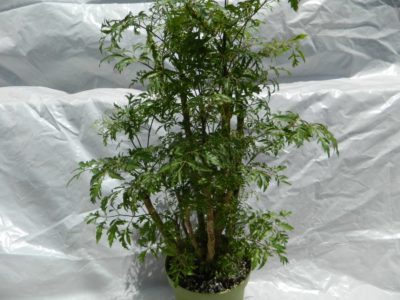

Growing problems and mistakes
Poliscias is highly resistant to infection with diseases and pests, and is rarely affected, even in a weakened state. The main problems arise when the technology of care is violated, the plant is placed in unsuitable conditions.
You can determine the discomfort of a flower by the state of the leaves - they lose their elasticity, dry out and become lethargic. As a rule, this occurs when there is a lack of lighting, non-compliance with the microclimate.
Expert opinion
Mokhov Andrey Petrovich
Graduated from KubSAU specialty: agronomy
To restore the decorative effect of the poliscias, it is required to monitor the stable moisture content of the substrate, maintain the watering regime and avoid keeping the flower in dark places.
Microclimate
The plant is whimsical to external conditions. If the requirements for growing are not met, there is a possibility of shedding foliage, a decrease in the growth rate. In summer, it needs stable heat in the temperature range from 17 to 24 ° C, in winter - 17–20 ° C.
For comfortable growth and preservation of decorativeness, good diffused light is required; direct sunlight on the leaves is undesirable. The optimal solution is a window sill on the east or west side of the apartment. In winter, additional illumination with a phytolamp is recommended for up to 5 hours a day. Air humidity should be in the range of 70–80%.
Expert opinion
Mokhov Andrey Petrovich
Graduated from KubSAU specialty: agronomy
To maintain the water balance of the cells, it is recommended to place a container with liquid next to the pot, and put wet pebbles or expanded clay into the pallet.
Watering
The soil in the pot should be carefully spilled until some of it is in the pan. After 20 minutes after watering, the excess water must be drained. The next watering is necessary when 2 cm of the top layer is dry. Excess moisture, like its lack, destroys the plant.
Is bonsai suitable for formation?
Some varieties of polisias are suitable for creating bonsai trees. The flower grows very slowly, pruning can be done no more than 2-3 times a year. Step-by-step instruction:
- Remove unwanted, dry and deformed parts of the plant as well as large leaves.
- Carry out a supportive pruning of the crown and branches, you can remove up to 20% of the total mass. Carry out the work with special scissors, the cut should be in the active growth zone.
- Align the shape so that the upper shoots are thinner than the lower ones.
After work, it is advisable to water the plant, and treat the cut sites with a special paste to avoid drying out and the development of diseases. Immediately after shaping, it is necessary to apply a wire to give the direction of growth of the branches.
What kind of soil is needed?
Polisias is unpretentious to the quality and composition of the soil. The substrate should be light, loose, well aerated and neutral. It is most convenient to purchase ready-made soil for ficuses or house palms, additionally adding brick chips or perlite to it to enhance looseness.
If you prefer to prepare the soil yourself, then you need to mix the following components in equal proportions:
- sod and leafy soil;
- peat;
- sand.
After that, be sure to water it abundantly with a 3% solution of potassium permanganate to prevent pest infestation.


